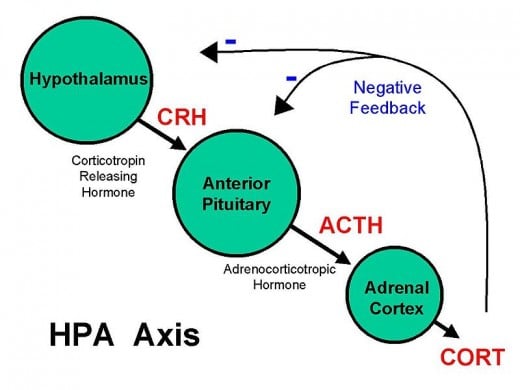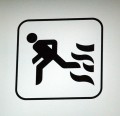Fight or Flight Response - Psychology

What is the Fight or Flight Response?
Also known as the acute stress response, this physiological and biological stress hormonal phenomenon has been present since the beginning of time.
This is the response in vertebrates that ultimately preserves the species. Whatever the perceived threat to safety, a split second decision must be made--whether to stay and fight or run for your life.
We see this in the wild when animals stalk their prey. Some animals are much better at fleeing and can outrun their predators. Others are better at outsmarting or overcoming their nemesis so stick around for the fight.
Whatever the choice--fight or flight--this response sets off chemical reactions first in the brain which then spread to the adrenal glands. The adrenals are the glands that release the powerful stress hormones necessary to combat the threat. It's an entirely physiological but extremely potent process that occurs when a potentially threatening situation occurs.
However, in today's world, the flight or fight response has taken on entirely new meanings. The acute stress response has evolved into something applicable in many aspects of life.

Acute Stress Response Can Be Useful
When we think about firemen or policemen who go into potentially life threatening situations every day, it's easy to see how a fight or flight response can be extremely helpful. While it's not the optimum mental state to be in, there's no other good explanation as to why some people run into dangerous situations rather than away from them.
Think of the mother who is able to grab a car bumper and lift a car off her child who is pinned beneath it--or the superhuman strength it must take for a wounded soldier to carry a comrade to safety from the battlefield.
Often in these situations, people who live through the experience say that they don't know what came over them. They went into a "zone" and were able to do something that they themselves could not visualize themselves doing under normal circumstances.
An acute stress response though is not a normal circumstance. Something occurs that requires an instant response--are you going to stay and tough it out in this situation or are you going to run for your life?
It's important to note that either of these choices require power and strength. The body has natural responses once the stress hormones are released, which in effect stop some processes within the body (like digestive, urinary or sexual functions). The hormones and the brain have taken over and now devote all the blood flow to the large muscles and parts of the body needing strength.
This can also affect certain senses such as sight, hearing or touch. This is nature's way of making sure that the body is primed for action. The main organs and muscles receive extra blood and nutrients while other processes are temporarily put on hold or go to sleep.
Built In Stress Response
In today's high stress society, the flight or fight response has become all too prevalent. On one level, it's still there being called into use in life or death situations, which is great. However, a built in stress response that was once used only for self preservation has now evolved into an emotional or psychological method of dealing with perceived threats.
Some common and everyday fight or flight reactions:
- worry and rumination--what will I do if?
- aggressiveness--like road rage or over-assertive behaviors
- violence
- argumentative or antisocial behaviors
- disregard for laws, rules and authority figures
- fears and phobias
- anxiety
- substance abuse
- withdrawal--emotional and physical
- homelessness
- mental illness
While some of these might seem shocking to be perceived as "flight" responses, homelessness for instance is a form of withdrawal from society.
Likewise, even constantly sitting in front of a television set is a form of escape and getting away from the perceived threats of society or homelife.
Reactions such as bullying or aggression towards others usually are precipitated by something in the person that triggers the predatory response of be killed before you are killed.
Environmental factors are contributing on a daily basis to people's stress levels. We may not even be aware of many of the reactions we have as we face common everyday occurrences like traffic jams, problems with coworkers, health issues, fatigue and sleep deprivation--along with a host of other seemingly nonsignificant stressors.
It is said today that millions of people are suffering the prolonged effects of an acute stress response that does not turn off. When the body is faced with multiple stressors that keep recurring, eventually the body deteriorates as normal processes are never allowed to resume.
In order to function appropriately, the body must recover from each fight or flight response before taking on another trigger. In a high stress society such as today's world, that sometimes seems impossible. This may be one of the most significant factors for the increase in health problems, mental illness, violence and death.

How the Body Reacts During Stress
Physical changes:
- heart rate goes up
- breathing rate increases
- lung capacity increases
- flushing or pallor may occur
- hearing may increase or decrease
- pupils dilate
- digestion slows
- blood vessels dilate
- vision becomes more focused
- shaking may occur
- tear production and salivation decrease
- disinhibition of spine reflexes which increases pain tolerance
- nutrients are dispersed to muscles for action
- muscles become stronger
- urinary, digestive and sexual function are put on hold
Some Common Fight or Flight Reactions
Reaction
| Flight
| Fight
|
|---|---|---|
Aggressiveness
| X
| |
Withdrawal
| X
| |
Substance abuse
| X
| |
Violence
| X
| |
Antisocial behavior
| X
| |
Homelessness
| X
| |
Heroic actions
| X
| |
Social anxiety
| X
| |
Phobias
| X
| |
PTSD
| X
| X
|
Poor concentration
| X
| |
Poor libido
| X
| |
Burnout
| X
| X
|
Road rage
| X
| |
Domestic violence
| X
| |
Depression
| X
|
Just some of the situations where fight or flight response may be staying turned "on."
Long Term Effects of Acute Stress Reactions
Some possible outcomes when faced with recurring events that have no period of recovery:
- posttraumatic stress disorder
- anxiety disorders
- panic disorders
- phobias
- insomnia
- social anxiety disorders
- emotional deregulation
- menstrual disorders
- poor concentration
- depression
- mood disorders
- fatigue syndromes
- withdrawal from society
Turning Off An Acute Stress Response
In natural circumstances and within the confines of nature, if someone or something survives the fight or flight response and comes out on the other side, the stress hormones recede gradually. The person or the animal return to their previous state and go on--until the next response is needed.
In the real world of today's society, where people seem to be bombarded with situations that trigger these psychologically draining responses, it's hard to remember sometimes that the responses need to be "shut off." At least until they are required to be used again in an applicable situation.
Not surprisingly, some people don't even know that the switch is still flipped on.
A vicious cycle can evolve where a person is continually on alert against a real or imagined "threat" which means living in a constant super vigilant state or one of hyperarousal. This is both mentally draining and physically exhausting.
How to turn off the acute stress response syndrome? Once the real danger or perceived danger has passed, it's important to do a body check. Have the heart rate and breathing returned to normal within about 30 or 40 minutes after the incident?
If not, one of the most recommended coping mechanisms is exercise. Waiting 30-40 minutes after a responsive incident allows the body to try to naturally calm itself back to a normal state. If that hasn't succeeded, simply working up a sweat is a recommended way to encourage the body to turn off the stress hormones.
The exercise doesn't have to last for any particular amount of time--it just has to make the person break into a sweat and stay there for a few minutes. This releases endorphins that recharge the body and change the complexion of behaviors that otherwise might stay "locked" in a ready position for battle or preservation.
Doing pushups, situps, jogging in place, doing jumping jacks, running up and down some stairs, basically anything that will make someone break into a sweat will stop the fight or flight response in its tracks.
The use of meditation and positive thinking or self talking are also beneficial things anyone can do anywhere to stop a stress reaction response. The important thing is to remember that someone trapped in a continuous fight or flight response is at high risk for poor outcomes over time.
Stress exists for a reason in the real world--it helps alert us to potential dangers and ramps us up to face things that need to be dealt with. We can see more clearly, handle things we thought we could never possibly manage before.
However, when the stress has passed, it's important to understand that just like in exercise, there must be a cooling down period and a recovery phase to get the body back to neutral or normal.
Whether it's pulling someone from a burning car on the side of the road or dealing with a coworker who has just embarrassed you in front of a room full of people, recognizing the symptoms and the natural progression of the reaction is key to restoring normal mental health and physical well being.








